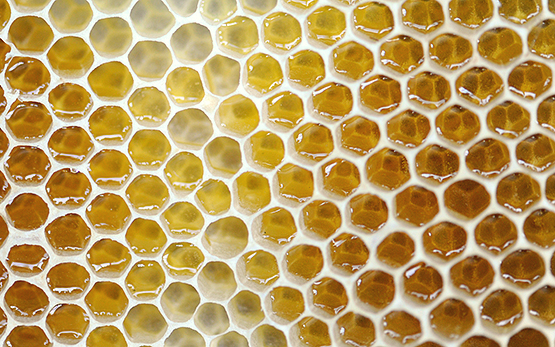Der Wassergehalt des von den Pflanzen produzierten Nektars kann variieren. Um seine Konservierung in den Waben zu gewährleisten, darf er nicht gären. Deshalb wird er von den Bienen in Honig umgewandelt, indem sie seinen Wassergehalt senken und folglich den Zuckergehalt erhöhen. Dies verhindert die Entwicklung der Mikroorganismen. In der Dunkelheit des Bienenstocks ist es schwierig, den Herstellungsprozess des Honigs zu beobachten. Aus diesem Grund ist er auch nur wenig erforscht. Um die Umwandlung von Nektar in Honig zu untersuchen, haben wir die Technik der Tomographie eingesetzt. Sie ermöglicht es, den Zuckergehalt des eingelagerten Nektars sehr präzise zu messen, ohne den Bienenstock öffnen zu müssen und das Bienenvolk zu stören.

Numéro du projet: 22.05.13.12.01
Diagnostic moléculaire des pathogènes des plantes: développement et utilisation de nouvelles méthodes de diagnostic
The precise identification of agricultural pests is an important basis for successful and sustainable crop protection. Today, modern diagnostic equipment enable reliable molecular species diagnostics in the field. Also, advanced algorithms are available to genetically characterize organisms, enabling to study their origin as well as their distribution histories. In this project, the latest molecular diagnostic methods and technologies are being used for reliable identification and epidemiological inference of harmful and beneficial organisms. This information is an important basis for preventing the introduction of undesirable organisms into Switzerland and for the further development of plant protection strategies.
ID Projet: 3758 Envoyer par e-mail
Responsable du projet
Suppléance
| Nom, Prénom | Site |
|---|---|
| Altenbach Denise | Changins |
| Apothéloz-Perret-Gentil Laure | Changins |
| Bacchetta-Reo Emanuela | Changins |
| Bänziger Irene | Reckenholz |
| Julmi Moreillon Corinne | Changins |
| Kellenberger Isabelle | Changins |
| Schumpp Olivier | Changins |
Debonneville C., Dubuis N., Schumpp O.
First detection of a 'Candidatus Phytoplasma solani'-related strain infecting sugar beet in Switzerland.
New Disease Reports, 51, (1), 2025, Article e70021.
Cabianca A.
Meloidogyne chitwoodi and M. fallax in Switzerland: Distribution, population differences and resistant plants.
Dans: Annual PhD meeting "Life After a PhD", 27-28 June, Natural History Museum of Neuchâtel. 27 June, Ed. Neuchâtel University, Neuchâtel (CH). 2024.
Oliveira C. J., Subbotin S. A., Desager J. A., Dahlin P., Vau S., Inserra R. N.
Morphological and molecular analysis of two mycophagous nematodes, Aphelenchoides bicaudatus and A. rutgersi (Nematoda: Aphelenchoididae) from Florida strawberry.
Journal of Nematology, 56, (1), 2024.
Debonneville C., Oggier A., Rizzoli A., Conedera M., Schumpp O.
First identification of a 'Candidatus Phytoplasma fragariae'-related strain infecting Corylus avellana in southern Switzerland.
New Disease Reports, 50, (1), 2024, 1-2.
Debonneville C., Linder C., Viret O., Jeanrenaud M., Schumpp O.
Detailed assessment of control measures against “flavescence dorée” allows reduction of pesticide use.
Phytopathogenic Mollicutes, 13, (1), 2023, 61-62.
Debonneville C., Groux R., Brodard J., Schumpp O.
The Complete Genome of the “Flavescence Dorée” Phytoplasma Reveals Characteristics of Low Genome Plasticity.
Dans: Bioinformatic Symposium. 16. May, Ed. Agroscope, Reckenholz. 2023, 1-6.
Sy E. T., Dahlin P.
Le nématode à galles des racines Meloidogyne enterolobii.
Agroscope. Fiche technique No. 152, 2023, 2 pp.
autres langues:
Schneeberger P. H. H., Gueuning M., Welsche S., Hürlimann E., Dommann J., Häberli C., Frey J. E., Sayasone S., Keiser J.
Different gut microbial communities correlate with efficacy of albendazole-ivermectin against soil-transmitted helminthiases.
Nature Communications, 13, 2022, 1-12.
Korneyev S. V., Smith J. J., Hulbert D. L., Frey J. E., Korneyev V. A.
A new Species of rhagoletis (Diptera, Tephritidae) from Switzerland, with discussion of its relationships within the genus.
Zoodiversity, 56, (1), 2022, 1-20.






